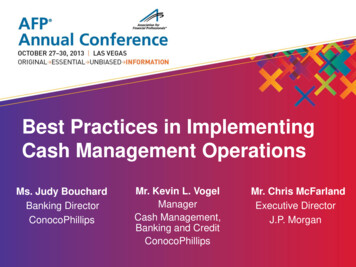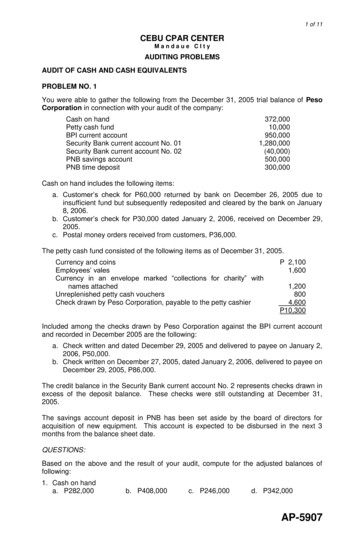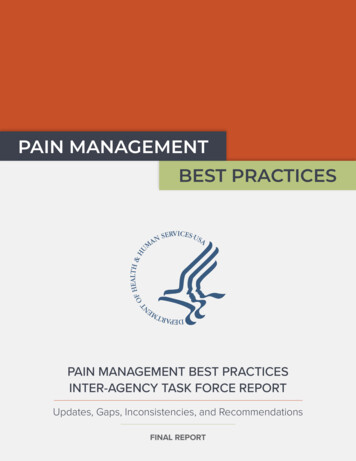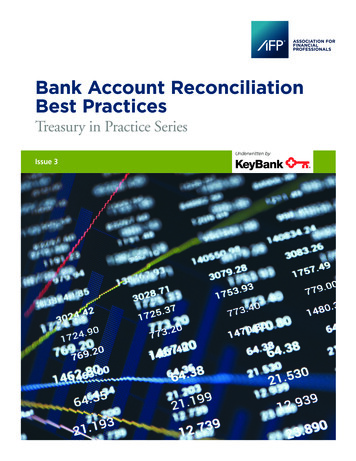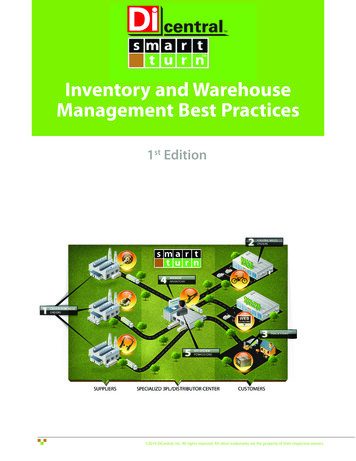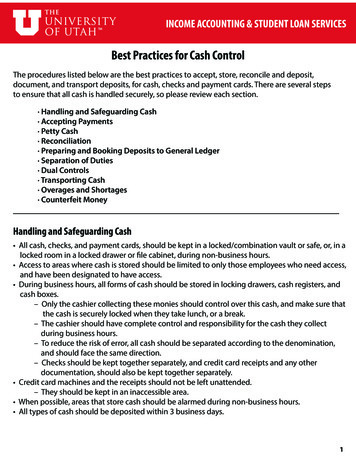
Transcription
INCOME ACCOUNTING & STUDENT LOAN SERVICESBest Practices for Cash ControlThe procedures listed below are the best practices to accept, store, reconcile and deposit,document, and transport deposits, for cash, checks and payment cards. There are several stepsto ensure that all cash is handled securely, so please review each section.· Handling and Safeguarding Cash· Accepting Payments· Petty Cash· Reconciliation· Preparing and Booking Deposits to General Ledger· Separation of Duties· Dual Controls· Transporting Cash· Overages and Shortages· Counterfeit MoneyHandling and Safeguarding Cash All cash, checks, and payment cards, should be kept in a locked/combination vault or safe, or, in alocked room in a locked drawer or file cabinet, during non-business hours. Access to areas where cash is stored should be limited to only those employees who need access,and have been designated to have access. During business hours, all forms of cash should be stored in locking drawers, cash registers, andcash boxes.– Only the cashier collecting these monies should control over this cash, and make sure thatthe cash is securely locked when they take lunch, or a break.– The cashier should have complete control and responsibility for the cash they collectduring business hours.– To reduce the risk of error, all cash should be separated according to the denomination,and should face the same direction.– Checks should be kept together separately, and credit card receipts and any otherdocumentation, should also be kept together separately. Credit card machines and the receipts should not be left unattended.– They should be kept in an inaccessible area. When possible, areas that store cash should be alarmed during non-business hours. All types of cash should be deposited within 3 business days.1
Accepting Payments All types of payments should be input into an electronic device, such as a cash register orcomputer terminal, or tracked manually with pre-numbered receipts, to ensure that all paymentsare documented. Payments for goods or services can be accepted in the form of cash and coin, checks, andpayment cards. Payments can be received in-person, by mail, or armored car delivery.In-Person Cash and Coin, and Check Payments Accepted Manually: Payments accepted by departments without an electronic device shouldbe tracked by pre-numbered receipts. When cash and coin payments are accepted as payment, they should always berecounted in front of the customer to confirm the amount received from the customer. A receipt should always be given to the customer for cash payments. If change is given back to the customer, the change should be counted back tocustomer, to confirm that the correct amount is given back. Checks should be endorsed immediately. § A completed receipt must be retained bythe department.In-Person Cash and Coin Payments: When cash and coin payments are accepted as payment, they should always berecounted in front of the customer to confirm the amount received from the customer. A receipt should always be given to the customer for cash payments. If change is given back to the customer, the change should be counted back tocustomer, to confirm that the correct amount is given back. Payments should be input, or rung in, on the cash register or computer terminal atthe same time they are received.In-Person Check Payments: Payments should be input, or rung in, on the cash register or computer terminal, asthey are received. Checks should be endorsed immediately. § A receipt should be given to customer.Mail Check Payments: All check payments should be logged daily. § Payments should be input, or rung in,on the cash register or computer terminal, daily when they are received. Checks should be endorsed immediately.Armored Card Delivered Cash and Check Deposits: A log should be kept of all daily deposits received. All deposits should be counted daily and input into the cash register or computerterminal, daily when they are received. § Checks should be endorsed immediately,if they have not been endorsed.2
Payment Cards: Payment cards can be accepted in-person, or by phone. When accepting an in-person payment the cashier should look at the card toconfirm that the card is signed, and belongs to the customer. The customer should always sign the payment card receipt, and the paymentshould be input, or rung in, on the cash register or computer terminal, whenreceived. Phone payment card payments should be input, or rung in, on the cash register orcomputer terminal, daily when received. Office receipts and any accompanying documentation should be kept secure.– The receipts and accompanying documentation should never be thrown inthe trash. They should be destroyed within 18 months. A receipt should be given to the customer.Petty Cash Departments needing to provide change, or reimbursements should request a petty cash fundfrom General Accounting. This cash should be counted daily and logged. When cash becomes depleted, a refund check should be requested by the petty cash custodian toAccounts Payable. This check can be cashed at the main Cashier’s window in the Student Services Building, room 165.Reconciliation In-Person and Mail Payments Input Into an Electronic Device:– The Cashier should balance their money to their daily receipts, per the totals on theirelectronic devices.– The device should be closed out daily, and a grand total tally should be printed.– Checks should be totaled with a calculator tape attached. Ensure that all checks are endorsed.– Cash and coin should be totaled.– The payment card machine should be closed out and settled, if applicable.– Any petty cash should be deducted from the cash, if applicable.– The remaining cash, the checks, and payment cards should balance to the amount of thedaily receipt grand total. In-Person and Mail Payments Accepted Manually:– The Cashier should balance their money to their daily receipts.– All pre-numbered receipts should be added to determine the daily grand total.– Checks should be totaled with a calculator tape attached. Ensure that all checks are endorsed.– Cash and coin should be totaled.– The payment card machine should be closed out and settled, if applicable.– Any petty cash should be deducted from the cash, if applicable.– The remaining cash, the checks, and payment cards should balance to the amount of thedaily receipt grand total.3 Daily receipts and money should be reconciled by a second employee.
Preparing and Booking Deposits to General Ledger Once a deposit has been reconciled, a departmental deposit is created, by another employee,not the Cashier. Employees must complete the on-line training, and the security form, to be granted access to theDepartmental Deposit Forms. This deposit form is completed according to the type of money being deposited. The appropriate chart fields and amounts are input on this form. The form is printed, and must be signed and verified by either the preparer’s cognizant authority,or another co-worker. A copy of the form and money are then delivered to the main Cashier’s office, using the methodslisted in Transporting Cash below.Separation of Duties The cashier accepting the daily payments balances these payments daily. This deposit goes to another employee to have the monies confirmed, and a departmental depositprepared with the appropriate chart fields. Another employee must confirm and approve the monies in the departmental deposit. Two Cashiers in the Cashier’s Office count the departmental deposit, or it is counted by a bankteller, if the deposit goes directly to the bank. · The department’s accountant confirms that thedeposit is booked to the correct chart fields, and balances to the department’s system.Dual Controls Dual controls should be established by departments to ensure that two employees count thecash, together, and deliver deposits to the Cashier’s Office, or the bank.Transporting Cash Completed deposits should be sent to the bank, or to the main Cashier’s Office in the StudentServices Building within 3 days. If delivered in-person to either the bank or the Cashier’s Office, 2 people should make the delivery.– Deposit should be delivered to the Cashier’s Office in an inconspicuous manner, such asUniversity campus envelope, or in a backpack or large bag.– If you walk on-campus to deliver your deposits, change you route and deliverytime regularly. Delivery to the bank or the Cashier’s Office may also be done by armored car service.Overages and Shortages When an overage or shortage is identified, a supervisor should recount the deposit. If it is a valid overage or shortage, an accounting entry should be made immediately to documentthe difference in the general ledger.4
Counterfeit Money Counterfeit bills can be any denomination. They can be detected by the way the bill feels, or by a print discrepancy. Once identified, the Secret Service should be notified.– The Secret Service will ask to have the bill surrendered to them. Your immediate supervisor should be notified, and the shortage will need to be booked. The main Cashier’s Office in the Student Services Building should also be notified.5
– The receipts and accompanying documentation should never be thrown in the trash. They should be destroyed within 18 months. A receipt should be given to the customer. Petty Cash Departments needing to provide change, or reimbursements should request a petty cash fund from General Accounting. This cash should be counted daily and logged. When cash becomes depleted, a

